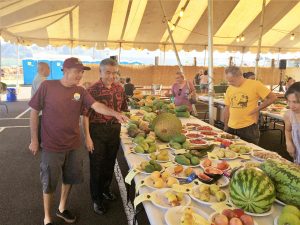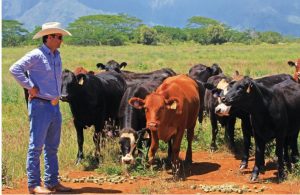“Farm to table” sounds fresh and appealing — like going to your nearest farmer’s market — but how many of us really know the hard work it takes to grow food? So when Governor Ige set doubling local food production as one of his administration’s goals, skeptics wondered, “Is that even possible?” The answer is yes, say state agriculture officials — with the right combination of available land and water, public-private investment, more support for current and future farmers, and new technology, such as high-tech, climate-controlled greenhouses on a scale that can make a difference for diversified ag.
It’s a complex matrix of pieces and a far cry from the days when large plantations took care of everything — from housing the workforce to quality assurance and distribution. Increasing local production includes supporting current growers as well as planning for a new kind of farming that relies less on back-breaking labor and more on “smart” technology to increase productivity. Determined farmers, aquaculture entrepreneurs and ag innovators are working with the state to increase Hawai‘i’s food security, but they need more support. “Currently, only 15 percent of food consumed in Hawai‘i is actually produced here,” said the governor. “We need to move island agriculture from the plantation era into the 21st century. That means combining sustainable practices with new technology to help current small farmers and attract a new generation of growers.”
The Ige administration has taken action on several fronts to make the transition to diversified agriculture possible, including: • Preserving thousands of acres of prime agricultural land statewide for food production and coordinating water-related policies
• Providing farmers and aquaculture operators with $8.1 million in loans and state long-term leases
• Developing public-private partnerships for greater capital investment
• Encouraging new farmers through business incubators and ag tech to help them become more productive
• Building community awareness through farm-to-table movements and the ‘Aina Pono, farm-to-school program
• Revitalizing dairy, egg and livestock production as well as employing new greenhouse technology and sustainable practices
New greenhouse technology – The game-changer for the future may be increased use of climate-controlled greenhouses that can grow more produce on a small amount of land. “This is the new generation of farming,” said James Nakatani, executive director of the Agribusiness Development Corporation (ADC). “It’s super compact and very productive compared with needing thousands of acres to farm.” For the past few years, Fred Lau, owner of Mari’s Garden in Mililani has been working with ADC to field test systems at the largest aquaponics greenhouse in the state. Every month Mari’s turns out 36,000 heads of baby romaine for several O‘ahu hotels and military commissaries. The pilot project comes from a $2 million collaboration between the state and Mari’s Garden to showcase best practices for hydroponic/aquaponic systems and greenhouse design. Now the plan is to take what’s been learned about greenhouse design adapted to the islands’ heat and humidity and build a next-generation greenhouse in Wahiawa, using sustainable practices and energy-efficient technology.
Whitmore Food Hub – The Hub is part of a master plan to make Central O‘ahu a major source of local food production. “To create a system for diversified ag and to meet new federal food safety standards, we’ve been working with Sen. Donovan Dela Cruz to bring together land development, infrastructure, renewable energy, ag tech research and training for 21st century jobs,” said ADC staffer Todd Low. A design for a Whitmore Food Hub recently won a prestigious 2018 American Architecture Award for being among the 100 best new building designs in the United States.
Villa Rose – A cage-free farm being built on former Dole Pineapple land on O‘ahu is expected to produce eggs by spring 2019. The farm is planned to be off the grid, with solar panels and battery storage. Up to one million laying hens will occupy the farm, to be built in phases over several years.
Kunoa Cattle Co. – A Kaua‘i-based ranch with the state’s largest USDA-inspected slaughterhouse on O‘ahu that produces grass-fed beef from 2,000 cattle. Named “Best New Business” in 2017 by Pacific Edge, its co-founder Bob Farias is a third-generation rancher who combines healthy grazing practices with sustainable systems.
“We’re assembling the pieces for a foundation we can take into the future,” said Nakatani.“With the threat of climate change and new federal food safety regulations, we’re focusing on sustainable, “green,” energy-efficient technology and strategies that can benefit farmers statewide to increase productivity and create jobs.”



